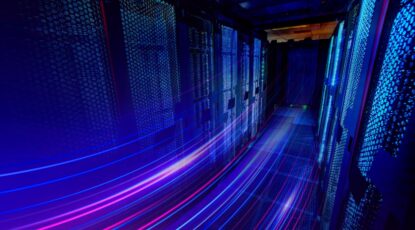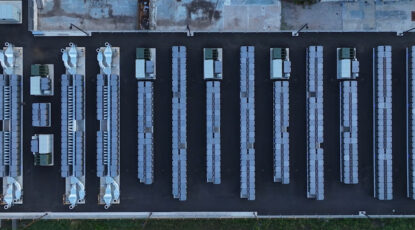A Bloom Energy Microgrid in Action
After a series of storms dumped 20 inches of heavy snow on Connecticut, downing trees and power lines, leaving 750,000 people without power for up to 11 days, the City of Hartford invested in a microgrid to protect against future weather-related outages. Working alongside Constellation in 2017, Bloom Energy completed a fuel cell microgrid in Hartford’s Parkville neighborhood. Since then, Bloom’s microgrid has powered the city through four more outages, providing a safe-haven for the community.
This 800 kW microgrid system generates 100% of the electricity for Hartford’s Parkville Elementary School, Dwight Branch Library, Parkville Senior Center and Charter Oak Health Center. The collaboration has strengthened Hartford’s energy infrastructure while reducing costs – an investment that could be made throughout the country given fuel cells’ flexibility. This highlights Bloom’s capability of providing resilient options to different regions throughout the country.
As a company, Bloom believes we must match energy resiliency – the ability to reliably deliver energy despite power disruptions caused by weather or other factors – with community needs, including low-carbon energy. Bloom’s work in Hartford is a clear example of leadership in providing resilient and reliable solutions for communities.
Fuel Cells as the Solution – From the Heartland to the Big City
But it’s not just Hartford. In fact, it can’t be. We need solutions that work in cities as effectively as they do in rural communities. This is why the ability to scale tends to be a key challenge for many renewable solutions outside of fuel cells.
Renewable technologies like wind and solar are critical players in today’s energy transition. Their costs have plummeted in recent years, in addition to having improved over decades of testing in the energy system. However, as we continue to introduce more clean renewables into the energy mix, the intermittent nature of their generation is a challenge that needs addressing. Batteries are an important part of this solution, but batteries alone cannot solve this problem. The truth is, even today’s best batteries are only good for a few hours.
Fuel cells, on the other hand, scale in a small footprint, meeting or exceeding the energy outputs of much larger wind and solar farms—using much less space. Fuel cells provide resilient energy to farms in America’s heartland, or for global businesses in the middle of large, world-class cities.
This distributed power generation avoids the vulnerabilities of conventional transmission and distribution lines, providing a buffer against power outages due to natural disasters, cyber threats, and other man-made disasters.
As energy grids incorporate renewables into their mix, our surface grids continue to get cleaner. However, the electricity generated by centralized power generation on the grid is still susceptible to severe weather events that can cause massive, widespread power outages. As long as communities rely on power from power lines, those lines are susceptible to extreme weather events. When tropical storm Isaias tore through the state of Connecticut in 2020, downed trees knocked out electrical power lines. Over 180,000 people lost power, some for up to 10 days. This means energy customers are still at risk of multi-day outages in the event of significant disruption.

Fuel cells are a distributed energy technology currently available with the ability to provide resilient 24/7, always-on power to protect businesses and community buildings from outages of any length. As an added bonus, they help to facilitate the energy transition.
We can deploy Bloom’s fuel cells to almost any environment to provide a resilient clean baseload of power – staying online even when the temperature spikes and the grid overloads, or when distribution infrastructure is damaged. Since fuel cells often generate power right where energy is being consumed, they can be deployed anywhere and are not dependent on the weather or encumbered by densely populated geography. Fuel cells can power a building in the footprint of a parking space, and can be flexibly sited, even on rooftops.
Fuel Cells for All Environments
As a resilient fuel source, the flexibility of fuel cells is key to transitioning to cleaner sources of fuel. Specifically, fuel cells – the building blocks of Bloom’s microgrids – tackle decarbonization because of their ability to run on natural gas, biogas, hydrogen, or a blend of fuels at high efficiency. Providing both resiliency and sustainability, fuel cells are an effective solution to the many diverse challenges our businesses and communities face.
Businesses ranging from hospitals, healthcare facilities, high tech manufacturing centers, data centers and retail stores need to continue operations when the grid goes down and are increasingly embracing microgrids with fuel cell technology for more reliable and resilient power.
Closing
In previous blog posts on extreme weather, we pointed to when Bloom helped The Home Depot power through outages stemming from a heatwave, and helped power a 911 call center in New York through Tropical Storm Isaias. As President Biden recently said during a visit to California, “extreme weather is here. The climate crisis isn’t going way… it’s [only] getting worse”.
Bloom Energy is a trusted partner providing microgrid solutions while ensuring that businesses have uninterrupted power. Our unique onsite power generation platform produce power where it’s consumed, so our customers avoid the threat of power disruptions and benefit from clean and affordable electricity.
Stay tuned for our next blog in the series where we’ll dive into the relationship between resiliency and verticals.



